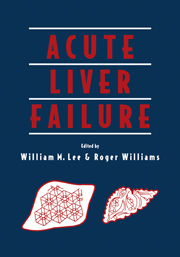Book contents
- Frontmatter
- Contents
- Preface
- Foreword
- Acknowledgments
- Contributors
- Part One Clinical Syndrome and Etiology
- 1 Classification and clinical syndromes of acute liver failure
- 2 Viral hepatitis and acute liver failure
- 3 Drug hepatoxicity as a cause of acute liver failure
- 4 Acetaminophen-induced acute liver failure
- 5 Unusual causes of acute liver failure
- 6 Pediatric aspects of acute liver failure
- Part Two Mechanisms of Disease and Multisystem Involvement
- Part Three Intensive Care Management
- Part Four Transplantation
- Part Five Artificial and Bioartificial Liver Devices
- Part Six Other Applications
- Index
- Plate section
5 - Unusual causes of acute liver failure
from Part One - Clinical Syndrome and Etiology
Published online by Cambridge University Press: 20 May 2010
- Frontmatter
- Contents
- Preface
- Foreword
- Acknowledgments
- Contributors
- Part One Clinical Syndrome and Etiology
- 1 Classification and clinical syndromes of acute liver failure
- 2 Viral hepatitis and acute liver failure
- 3 Drug hepatoxicity as a cause of acute liver failure
- 4 Acetaminophen-induced acute liver failure
- 5 Unusual causes of acute liver failure
- 6 Pediatric aspects of acute liver failure
- Part Two Mechanisms of Disease and Multisystem Involvement
- Part Three Intensive Care Management
- Part Four Transplantation
- Part Five Artificial and Bioartificial Liver Devices
- Part Six Other Applications
- Index
- Plate section
Summary
INTRODUCTION
Viral hepatitis, hepatotoxic drugs, and toxins make up the common causes of acute liver failure. Using a thorough case history, in combination with liver function studies and serological data, the diagnosis is usually very straightforward. However, less common etiologies must be investigated when the initial evaluation is not conclusive. In this chapter, some of the more unusual causes of acute liver failure will be discussed, along with the specific features of their presentation, and distinctive aspects of their management.
BUDD-CHIARI SYNDROME
Budd–Chiari syndrome is defined as obstruction to outflow in the major hepatic veins. Most commonly, the underlying pathology is thrombosis in these vessels. Many patients have an underlying coagulopathy or tendency to thrombosis, such as a myeloproliferative disorder, malignancy, polycythemia rubra vera, paroxysmal nocturnal hemoglobinuria, or deficiencies in protein C, protein S, or antithrombin III. The use of oral contraceptives has also been implicated in Budd–Chiari syndrome. Although not common in Western society, anatomical anomalies such as membranous webs of the inferior vena cava (IVC) can also impede the flow of blood from the liver. Whatever the underlying etiology, the high pressures which are transmitted to the liver result in progressive hepatocyte death, portal hypertension, and liver failure (Mitchell et al. 1982; Gupta et al. 1986).
Most patients with Budd–Chiari syndrome present with a subacute illness of less than three months' duration, characterized by ascites, abdominal pain, and hepatomegaly.
- Type
- Chapter
- Information
- Acute Liver Failure , pp. 43 - 52Publisher: Cambridge University PressPrint publication year: 1996



